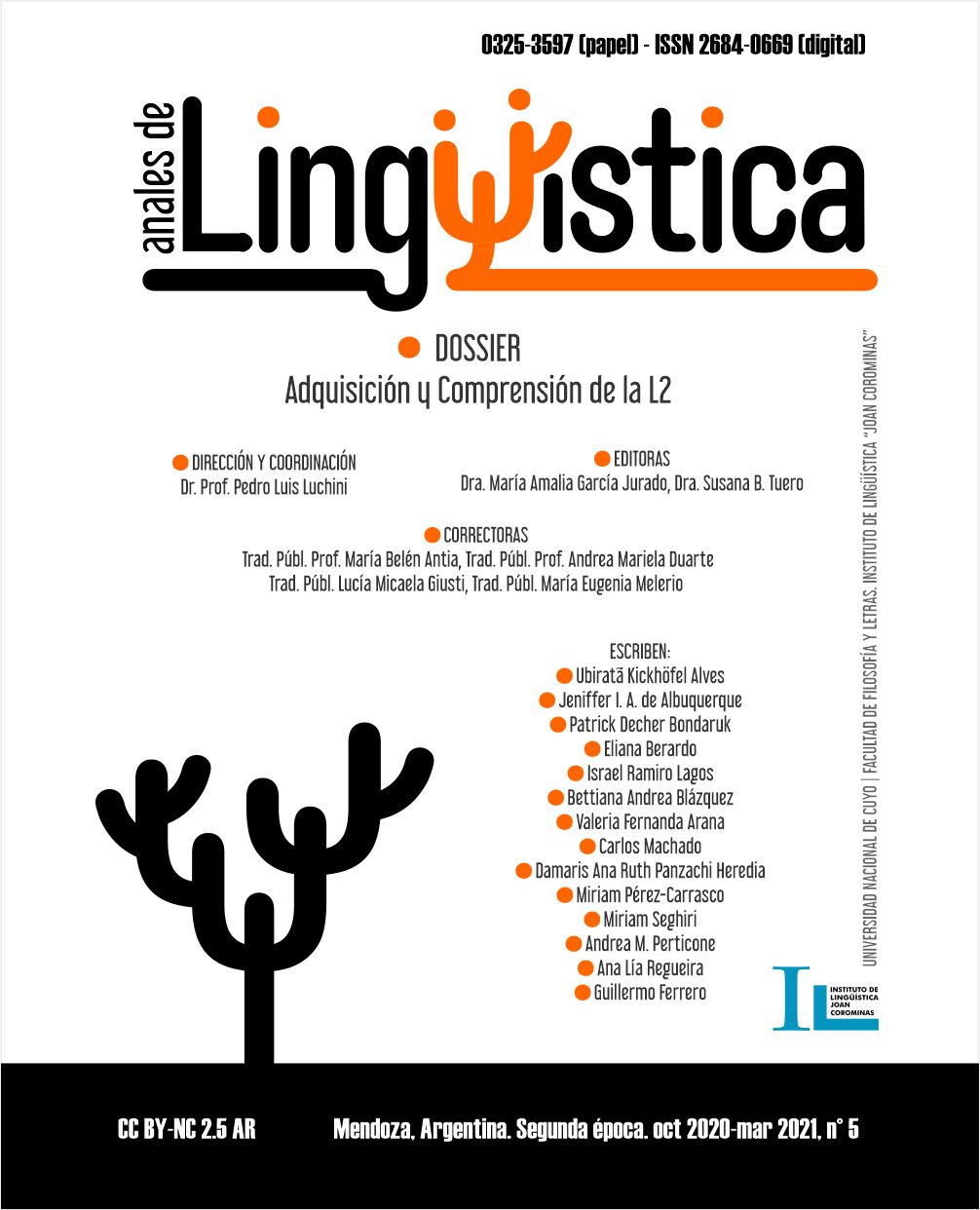Focus on meaning and focus on forms in English intonation categorisation
Keywords:
L2 intonation categorisation, focus on form, focus on meaningAbstract
This study investigated the categorisation of two nuclear pitch accents in English by River Plate Spanish speakers using two different listening modes: listening with a focus on intonational meaning or function and listening with a focus on intonational forms. Thirty-two participants listened to intonational minimal pairs differing in nuclear pitch accents, the forms H* L- L% and H* L- H%. In the first test, they were asked to decide between two pragmatic meanings conveyed by the speaker: making a statement/telling or asking/checking. In the second test, with the same stimuli, they had to decide if the nuclear pitch accent was either falling or falling-rising. The results showed that focus on form promoted a more successful categorisation of H* L- L% as statement, but hindered the categorisation of H* L- H% as question. On the other hand, a focus on forms facilitated the categorisation of the H* L- H% form as falling-rising, whereas it hindered the categorisation of H* L- L% as falling. In view of the L2LP model, it was concluded that a focus on forms promotes more accurate perception of the boundary tone H% within the new scenario., whereas it may lead to an erroneous cue weighting in the similar scenario. A focus on meaning promotes a more accurate categorisation of forms in the similar scenario, but not in the new scenario. Thus, a new L2 form becomes more or less readily accessible depending on the listening modality.
References
Ayers, G. M. & Beckman, M. E. (1997). Guidelines for ToBI labelling (version 3.0). The Ohio State University Research Foundation. Accessed on July 6, 2020, from http://www.ling.ohio-state.edu/tobi.html
Best, C. (1995). A direct realist view of cross-language speech perception. In: W. Strange (Ed.). Speech perception and linguistic experience (pp. 167-200). Timonium, MD: York Press.
Boersma, P. (2003). Stochastic optimality theory. Meeting of the Linguistic Society of America in Atlanta, 3, p. 2003.
Boersma, P. y Weenink, D. (2019). Praat: Doing Phonetics by Computer (Version 6.0.47) [Computer software]. http://www.praat.org/
Braun, B., Kochanski, G., Grabe, E. & Rosner, B. S. (2006). Stable attractors in intonation: Evidence for discrete choices in English prosody. Journal of the Acoustical Society of America, 119 (6), pp. 4006-4015.
Brazil, D. (1997). The Communicative Value of Intonation in English. Cambridge: Cambridge University Press.
Council of Europe. (2001). Common European Framework of Reference for Languages (CEFR). Accessed on June 30, 2020, from https://www.coe.int/en/web/common-european-framework-reference-languages/level-descriptions
Cruttenden, A. (1981). Falls and rises: Meanings and universals. Journal of Linguistics, 17 (1), pp. 77-91.
Cruttenden, A. (2007). Intonation. Cambridge: Cambridge University Press.
Escudero, P. R. (2005). Linguistic Perception and Second Language Acquisition. Explaining the attainment of optimal phonological categorization. The Netherlands: LOT Publications.
Ellis, R. (1994). The Study of Second Language Acquisition. Oxford: Oxford University Press.
Ellis, R. (2003). Task-based language learning and teaching. Oxford: Oxford University Press.
Flege, J. E. (1995). Second language speech learning: theory, findings, and problems. In: W. Strange (Ed.). Speech perception and linguistic experience (pp. 233-277). Timonium, MD: York Press.
Gabriel, C., Pesková, A., Labastía, L. & Blázquez, B. (2013). La entonación en el español de Buenos Aires. En L. Colantoni & C. Rodríguez Louro(Eds.). Perspectivas teóricas y experimentales sobre el español de la Argentina (pp. 99-115). Madrid, Frankfurt am Maim: Iberoamericana, Vervuert.
Grabe, E., Rosner, B. J., García Albea, E. & Zhou, X. (2005). Perception of English Intonation by English, Spanish and Chinese Listeners. Language and Speech 46 (4), pp. 375-401.
Hadding-Koch, K. & Studdert-Kennedy, M. (1964). Intonation contours evaluated by American and Swedish test subjects. Proceedings of the 5th International Congress of Phonetic Sciences, pp. 326-331.
Halliday, M. A. K. (1967). Intonation and Grammar in British English. The Hague: Mouton.
Heeren, W., Bibyk, S., Gunlogson, C., & Tanenhaus, M. (2015). Asking or telling: real-time processing of prosodically distinguished questions and statements. Language and Speech, 58 (4), pp. 474-501.
House, D. (1990). Tonal Perception in Speech. Lund: Lund University Press.
Jilka, M. (2000). The contribution of intonation to the perception of foreign accent [Doctoral dissertation]. University of Stuttgart.
Keijzer, M. (2007). Last in first out? An investigation of the regression hypothesis in Dutch emigrants in Anglophone Canada [Doctoral dissertation, Vrije Universiteit Amsterdam]. Research VU. https://research.vu.nl/en/publications/last-in-first-out-an-investigation-of-the-regression-hypothesis-i
Ladd, R. (1996). Intonational Phonology. Cambridge: Cambridge University Press.
Lindsey, G. (2017). English after RP. Southern British Pronunciation Today. Pilar: Tequisté.
Long, M. (1991). Focus on Form: A Design Feature in Language Teaching Methodology. In K. De Bot, R. Ginsberg & C. Kramsch (Eds.). Foreign Language Research in Cross-Cultural Perspectives (pp. 39-52). Amsterdam: John Benjamins.
McLaughlin, B. (1987). Theories of second-language learning. London: Arnold.
Mennen, I. (1998). Second language acquisition of intonation: The case of peak alignment. Proceedings of the Linguistics Society of Chicago, 34, pp. 327-341.
O’Connor, J. D. & Arnold, G. F. (1973). Intonation of Colloquial English. London: Longman.
Pierrehumbert, J. B (1980). The phonology and phonetics of English intonation [Doctoral dissertation, Massachusetts Institute of Technology]. DSpace@MIT. https://dspace.mit.edu/handle/1721.1/16065
Pierrehumbert, J. & Steele, S. (1989). Categories of tonal alignment in English. Phonetica, 46 (4), pp. 181-196.
Prince, A. & Smolensky, P. (1993). Optimality theory: Constraint interaction in generative grammar. Rutgers Center for Cognitive Science. http://roa.rutgers.edu/files/537-0802/537-0802-PRINCE-0-0.PDF
Rauber, A., Rato, A., Kluge, D. & Santos, G. R. (2012). TP: Testes / Treinamentos de Percepção (Version 3.1) [Computer software]. http://www.worken.com.br/tp_regfree.php/
Robinson, P. (2005). Cognitive complexity and task sequencing: Studies in a componential framework for second language task design. International Review of Applied Linguistics, 43, pp. 1-32.
Schmid, M. (2020, May 5). Language attrition. https://l1attrition.files.wordpress.com/2019/02/english-1.pdf.
Skehan, P. (Ed.). (2014). Processing Perspectives on Task Performance. London: John Benjamins.
Studdert-Kennedy, M. & Hadding-Koch, K. (1964). An experimental study of some intonation contours. Phonetica, 11 (3-4), 175-185.
Sweller, J. (2010). Cognitive Load Theory: Recent Theoretical Advances. In J. Plass, R. Moreno & R. Brünken (Eds.). Cognitive Load Theory (pp. 29-47). Cambridge: Cambridge University Press. DOI:10.1017/CBO9780511844744.004
Tench, P. (1996). The Intonation Systems of English. London: Cassell.
Wells, J. C. (2006). English intonation. An introduction. Cambridge: Cambridge University Press.
Zárate-Sández, G. (2018). "Was that a question?" Perception of utterance-final intonation among L2 learners of Spanish. In J. Levis (Ed.). Proceedings of the 9th Pronunciation in Second Language Learning and Teaching Conference (pp. 76-86). Ames, IA: Iowa State University.
Downloads
Published
How to Cite
Issue
Section
License
Copyright (c) 2021 Anales de Lingüística
Esta obra está bajo una Licencia Creative Commons Atribución 2.5 Argentina.
Los/as autores/as que publican en esta revista están de acuerdo con los siguientes términos:
1. Los/as autores conservan los derechos de autor y garantizan a la revista el derecho de ser la primera publicación del trabajo bajo una licecncia Creative Commons Atribución 2.5 Argentina (CC BY 2.5 AR) . Por esto pueden compartir el trabajo con la referencia explícita de la publicación original en esta revista.
2. Anales de lingüística permite y anima a los autores a difundir la publicación realizada electrónicamente, a través de su enlace y/o de la versión postprint del archivo descargado de forma independiente.
3. Usted es libre de:
Compartir — copiar y redistribuir el material en cualquier medio o formato
Adaptar — remezclar, transformar y construir a partir del material para cualquier propósito, incluso comercialmente.












